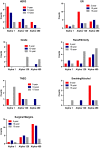Machine Learning to Discern Interactive Clusters of Risk Factors for Late Recurrence of Metastatic Breast Cancer
- PMID: 35008417
- PMCID: PMC8750735
- DOI: 10.3390/cancers14010253
Machine Learning to Discern Interactive Clusters of Risk Factors for Late Recurrence of Metastatic Breast Cancer
Abstract
Background: Risk of metastatic recurrence of breast cancer after initial diagnosis and treatment depends on the presence of a number of risk factors. Although most univariate risk factors have been identified using classical methods, machine-learning methods are also being used to tease out non-obvious contributors to a patient's individual risk of developing late distant metastasis. Bayesian-network algorithms can identify not only risk factors but also interactions among these risks, which consequently may increase the risk of developing metastatic breast cancer. We proposed to apply a previously developed machine-learning method to discern risk factors of 5-, 10- and 15-year metastases.
Methods: We applied a previously validated algorithm named the Markov Blanket and Interactive Risk Factor Learner (MBIL) to the electronic health record (EHR)-based Lynn Sage Database (LSDB) from the Lynn Sage Comprehensive Breast Center at Northwestern Memorial Hospital. This algorithm provided an output of both single and interactive risk factors of 5-, 10-, and 15-year metastases from the LSDB. We individually examined and interpreted the clinical relevance of these interactions based on years to metastasis and reliance on interactivity between risk factors.
Results: We found that, with lower alpha values (low interactivity score), the prevalence of variables with an independent influence on long-term metastasis was higher (i.e., HER2, TNEG). As the value of alpha increased to 480, stronger interactions were needed to define clusters of factors that increased the risk of metastasis (i.e., ER, smoking, race, alcohol usage).
Conclusion: MBIL identified single and interacting risk factors of metastatic breast cancer, many of which were supported by clinical evidence. These results strongly recommend the development of further large data studies with different databases to validate the degree to which some of these variables impact metastatic breast cancer in the long term.
Keywords: Markov Blanket and Interactive Risk Factor Learner (MBIL); causal learning; machine learning; metastasis; metastatic breast cancer; risk factors.
Conflict of interest statement
The authors declare no conflict of interest.
Figures



Similar articles
-
Leveraging Bayesian networks and information theory to learn risk factors for breast cancer metastasis.BMC Bioinformatics. 2020 Jul 10;21(1):298. doi: 10.1186/s12859-020-03638-8. BMC Bioinformatics. 2020. PMID: 32650714 Free PMC article.
-
An algorithm for direct causal learning of influences on patient outcomes.Artif Intell Med. 2017 Jan;75:1-15. doi: 10.1016/j.artmed.2016.10.003. Epub 2016 Nov 5. Artif Intell Med. 2017. PMID: 28363452 Free PMC article.
-
New insights into patterns of first metastatic sites influencing survival of patients with hormone receptor-positive, HER2-negative breast cancer: a multicenter study of 271 patients.BMC Cancer. 2021 Apr 29;21(1):476. doi: 10.1186/s12885-021-08219-3. BMC Cancer. 2021. PMID: 33926418 Free PMC article.
-
Overview of resistance to systemic therapy in patients with breast cancer.Adv Exp Med Biol. 2007;608:1-22. doi: 10.1007/978-0-387-74039-3_1. Adv Exp Med Biol. 2007. PMID: 17993229 Review.
-
A solitary brain metastasis as the only site of recurrence of HR positive, HER2 negative breast cancer: a case report and review of the literature.J Med Case Rep. 2021 Jan 7;15(1):4. doi: 10.1186/s13256-020-02615-2. J Med Case Rep. 2021. PMID: 33407851 Free PMC article. Review.
Cited by
-
Artificial Intelligence in Oncology: A Topical Collection in 2022.Cancers (Basel). 2023 Feb 7;15(4):1065. doi: 10.3390/cancers15041065. Cancers (Basel). 2023. PMID: 36831407 Free PMC article.
-
Survival analysis of recurrent breast cancer patients using mix Bayesian network.Heliyon. 2023 Sep 21;9(10):e20360. doi: 10.1016/j.heliyon.2023.e20360. eCollection 2023 Oct. Heliyon. 2023. PMID: 37780765 Free PMC article.
-
Bayesian Model Prediction for Breast Cancer Survival: A Retrospective Analysis.Eur J Breast Health. 2025 Jun 20;21(3):255-264. doi: 10.4274/ejbh.galenos.2025.2025-2-14. Epub 2025 May 27. Eur J Breast Health. 2025. PMID: 40421497 Free PMC article.
References
-
- Davies C., Pan H., Godwin J., Gray R., Arriagada R., Raina V., Abraham M., Medeiros Alencar V.H., Badran A., Bonfill X., et al. Long-term effects of continuing adjuvant tamoxifen to 10 years versus stopping at 5 years after diagnosis of oestrogen receptor-positive breast cancer: ATLAS, a randomised trial. Lancet. 2013;381:805–816. doi: 10.1016/S0140-6736(12)61963-1. - DOI - PMC - PubMed
Grants and funding
LinkOut - more resources
Full Text Sources
Research Materials
Miscellaneous

